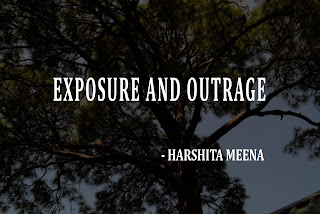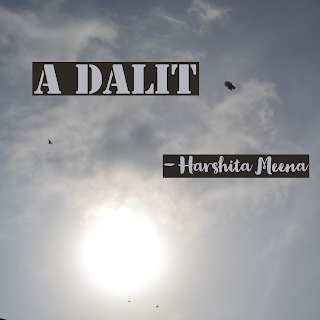Exposure and Outrage
A week back, I sat on my chair to write upon caste and rape realities in India. It was a time where the case struck amongst a vast majority and erupted protests all over the nation. Today, I sit again to continue where I left off. I would provide clarification as to why I left it off. The thing is, I couldn’t fathom how one may walk on the path of rectification of this cruelty after it has taken us by its throat. Our outrage against it comes off as a squeak while the monster keeps us pinned to the wall. I’d come across call for ‘justice’ for Manisha only to sigh at the fact that we’re asking justice for her from a world that failed her.
I’ll talk about how this monster is so much bigger than us
but first, let’s look into the dynamics of its coverage.
Morbidity of this alleged caste rape surfaced our timelines
and yet again gave us another chance to get rid of our collective guilt by
showing support that mixed so well with the public fervor. We looked at it
horrified with disgust even though the disgust only penetrated through to us
because this case was another trespass to our threshold of visible cruelty. You
know what they say when they get to see the atrocities on the marginalized in
its top-notch cruelest embodiment: ‘Enough is Enough’. I’ll call it mockery upon
the fates of thousand others who didn’t cut the line of ‘enough’ as per this
righteous judgement. The atrocities herein are the culmination of a social
standing that leaves one prone to be devoured and disrespected at the whim one
which is handed the power and legitimacy to do so. Thereby element of caste is
grossly infused with the gender in such matters and any attempt to separate the
two would render an incomplete view of the atrocity. It’s funny how political
outrage on this issue felt no more than a march on the dead bodies of the Dalit
women who have faced a similar fate. More amusing is the show of solidarity.
What does this solidarity mean to you? Is it limited to cloud generated uproar
for you to chime in or do you see these subtleties in your life?
I’ll come to the big question. What makes you look at it now
and not the million other times a similar story has repeated itself before? For
starters, most of you would look at it as long as it is fed to you through your
screens. The rape of a 19-year-old Dalit woman in Hathras was another normative
incident until it was not. What shifted this case out of the norm is the
unlawful disposal of the victim’s dead body by UP police and its eminent
broadcast over to the world. I’m sure present-day India would have similar
caste-based heinous acts in its nooks and crannies very much so unnoticed. This
case turned out to be an exception, not only so but also a focal point for mass
outrage.
I can’t help but be critical of how the circumstances have
unfolded. While I’m glad the anti-Dalit attitude of Indian Administration is
now out of the shadows into public scrutiny, I’d also like to highlight a sense
of hypocrisy within this outrage. 17th October had another reporting of a
17-year-old Dalit girl allegedly raped and murdered by her landlord which
further turned into unlawful disposal of the victim’s dead body by Delhi
police. New normal? Where’s the coverage? Where’s the outrage?
The same media houses which were brandishing the Hathras
issues now seem eerily silent, at times I wonder whether the selection in
putting up a story revolves around burying another. This brings forth an
orchestrated triggering of our emotions in a systematic manner to get the
optimal response. The response is a source of distraction from what prevails
behind these headlines.
While I’m way beyond the point of asking redressal from authorities and politicians, the least I can do is to put a magnifying glass over our attitude.
I’d get the monster into the picture again.
It’s a cultural trope that grapples us when we realize it to
be away and distant from us for it lives inside us. You feed it by running away
from it. You condemn it by pointing your fingers towards a similar monster
inside another. One example of it would be our fair share of resistance against
the government of India in the matters of the brutal rape and what we got out
of it. Our heartfelt resistance gave platforms to political parties to sway the
public wherever they need it while the cases kept piling upon one another. One might
say Nirbhaya got us procedural fluidity, but the same old question of a legal
amendment bringing social change arises. What it brought to us was a
much-needed change in the legal definition of rape and not a process through
which we nip it in the bud. The bud in this context is our attitude towards
society’s problems, one where we lay forth the onus of its eradication upon an
entity which feeds off it. The same applies to caste dimensions, even more so
than it does to rape for one may easily carry a casteist attitude and lead a
highly respectful life in this country.
Over the time I’ve realized the ‘possibility of Change’ may
only come when we look at this ‘social issue’ as a massive personal liability,
there is no other way you get a bunch of idiots to understand that the item
numbers they so dearly ignore are a form of perpetual and perennial
indoctrination of a female body ready to be served on a platter for this rape
capital to mutilate. Alas, it’s our time to introspect now of our compliance to
a rigged system of caste which has made it possible for a Dalit woman to die a
death you wouldn’t wish upon your enemies.
The monster merely resides in our choice to ignore the part
we’re playing in these social mayhems to perpetrate. For it is easier to shout
against the obviously guilty than to take a step back and open your eyes to
accept your own shortcomings. Change that comes out of latter remains to be
more worthwhile against the omnipotent evils of the society. Probably the only
one you’re in control of.



Very well written!
ReplyDelete